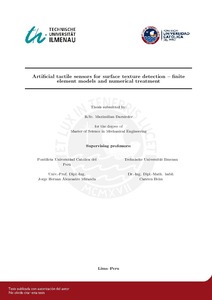Artificial tactile sensors for surface texture detection-finite element models and numerical treatment
Abstract
The biological example of vibrissa-type sensors in the animal realm is attributed with impressive sensing capabilities. A recently discovered ability is the surface discrimination task. Preceding research on the topic elaborated certain hypotheses for the functionality of the sensor. The scientific work is predominantly based on an empirical approach closely related to the biological example. Complex and highly nonlinear mechanical interrelations and tribological aspects of the contact frequently remain unconsidered. In the interplay between the properties of the biological example and the desired technical realization of the sensor concept, the present thesis incrementally develops a complex mechanical model. Its purely numerical treatment is based on the finite element method framed in the software package ANSYS. Following three modeling stages, the nonlinear structural model is successively implemented firstly enhancing the contact formulation and secondly including dynamic effects in the computation. The attributes of the biological example like elastic support, pre-curvature and conicity are incorporated and their effects are related to the desired sensor function. Beside the characteristic of the sensor system, elaborated through parameter studies, special emphasis is placed on the determination of the working range and its limiting borderlines as well as the uncovering of problematic aspects of the concept. The complex picture of the static behavior of the sensor system is complemented by a first dynamic calculation in close proximity to an experiment, which is conducted in parallel. The juxtaposition of the outcomes are interpreted and a proposal for a measurement strategy is outlined.
Temas
Sensores táctiles
Método de elementos finitos
Análisis numérico
Método de elementos finitos
Análisis numérico
Para optar el título de
Maestro en Ingeniería Mecánica





